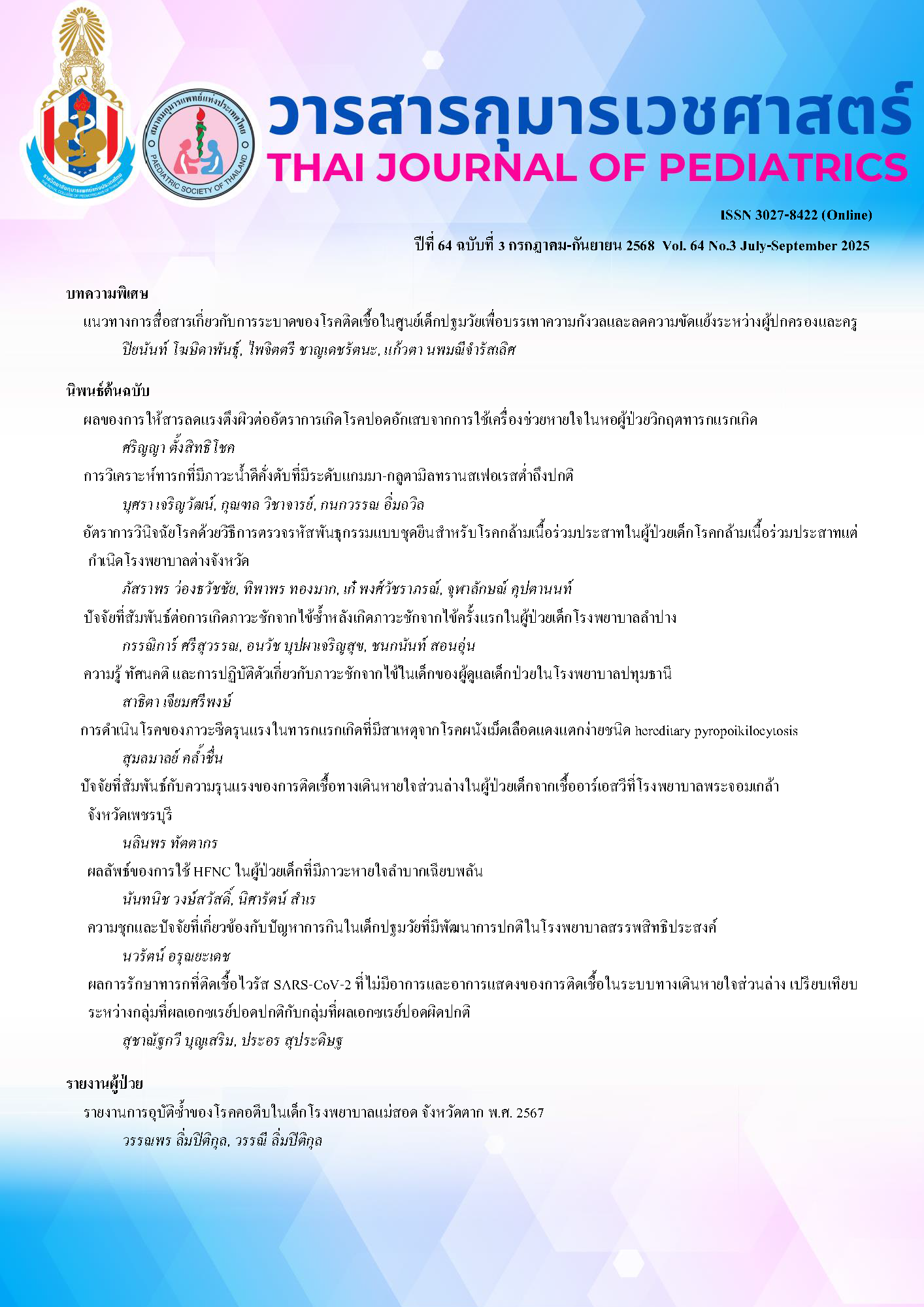Diagnostic yield of neuromuscular gene panel in pediatric patients with congenital neuromuscular disorders in provincial hospitals
Keywords:
Diagnostic yield, Hereditary neuromuscular disorders, Gene panelAbstract
Background: Congenital neuromuscular disorders are a major cause of impaired muscle function in children. In provincial hospitals, access to diagnostic investigations is limited, particularly in access to specialized investigations such as muscle biopsy. Recently, the implementation of gene panel testing can improve diagnostic accuracy and ensure appropriate treatment for affected patients.
Objectives: To study diagnostic yield of neuromuscular gene panel in pediatric patients with congenitalneuromuscular disorders in provincial hospitals.
Methods: This prospective study involved pediatric patients with suspected congenital neuromuscular disorders, initially assessed by pediatric neurologists at provincial hospitals between April 1, 2022, and March 31, 2024. Genetic testing available domestically was performed based on clinical presentation included multiplex ligation-dependent probe amplification (MLPA) for duchenne muscular dystrophy (DMD), SMN gene, and CMT1A and HNPP. After normal results from these initial tests, patients received genetic counseling and were referred for further blood testing using a targeted gene panel comprising 211 genes associated with neuromuscular disorders. Collected data were analyzed using descriptive statistics.
Results: Six patients participated in the research, 67% were male. The youngest patient was 10 months old and the oldest was 14 years and 4 months. The mean age of symptom onset was 2 years and 3 months (± 27 months). One patient had a family history of muscle weakness. Pathogenic variants in the DMD gene were identified in two patients, both of whom were diagnosed with Duchenne muscular dystrophy. One patient was found to have a variant in the GAA gene; however, subsequent GAA enzyme assay revealed no abnormality, and a definitive diagnosis could not be established. Three patients were found to have variants of uncertain significance. Therefore, the diagnostic yield of targeted gene panel testing for congenital neuromuscular disorders in this study was 33%.
Conclusion: Targeted gene panel testing for neuromuscular disorders is beneficial in facilitating diagnosis of congenital neuromuscular conditions in pediatric patients from provincial hospitals. This approach reduces the need for invasive procedures and enhances diagnostic and treatment opportunities for children in rural area.
Downloads
References
Westra D, Schouten MI, Stunnenberg BC, Kusters B, Saris CGJ, Erasmus CE, et al. Panel-based exome sequencing for neuromuscular disorders as diagnostic service. J Neuromuscul Dis. 2019;6:241-58.
Bozovic IB, Maver A, Leonardis L, Meznaric M, Osredkar D, Peterlin B. Diagnostic yield of exome sequencing in myopathies: Experience of Slovenian tertiary centre. PLOS ONE. 2021;16:e0252953.
Haskell GT, Adams MC, Fan Z, Amin K, Guzman Badillo RJ, Zhou L, et al. Diagnostic utility of exome sequencing in the evaluation of neuromuscular disorders. Neurol Genet. 2018;4:e212.
Beecroft SJ, Yau KS, Allcock RJN, Mina K, Gooding R, Faiz F, et al. Targeted gene panel use in 2249 neuromuscular patients: The Australasian referral center experience. Ann Clin Transl Neurol. 2020;7:353-62.
Ankala A, da Silva C, Gualandi F, Ferlini A, Bean LJ, Collins C, et al. A comprehensive genomic approach for neuromuscular diseases gives a high diagnostic yield. Ann Neurol. 2015;77:206-14.
Winder TL, Tan CA, Klemm S, White H, Westbrook JM, Wang JZ, et al. Clinical utility of multigene analysis in over 25,000 patients with neuromuscular disorders. Neurol Genet. 2020;6:e412.
Kay WP Ng, Chin H-L, Chin A XY, Li-Meng Goh D. Using gene panels in the diagnosis of neuromuscular disorders: A mini-review. Front Neurol. 2022;13:997551.
Engel AG, Shen X-M, Selcen D, Sine SM. Congenital myasthenic syndromes: Pathogenesis, diagnosis, and treatment. Lancet Neurol. 2015;14:420-34.
North KN. Clinical approach to the diagnosis of congenital myopathies. Semin Pediatr Neurol. 2011;18:216-20 .
Das S, Dubey A. A comprehensive review on spinal muscular atrophy (SMA). Perception in reproductive medicine. 2021;4:333-7.
Thangarajh M. The Dystrophinopathies. Continuum (Minneap Minn) 2019; 25: 1619-39.
Skre H. Genetic and clinical aspects of Charcot-Marie-Tooth’s disease. Clin Genet. 1974;6:98-118 .
Okubo M, Minami N, Goto K, Goto Y, Noguchi S, Mitsuhashi S, et al. Genetic diagnosis of Duchenne/Becker muscular dystrophy using next-generation sequencing: Validation analysis of DMD mutations. Journal of human Genetics. 2016;61:483-9 .
Gatta V, Scarciolla O, Gaspari AR, Palka C, De Angelis MV, Di Muzio A, et al. Identification of deletions and duplications of the DMD gene in affected males and carrier females by multiple ligation probe amplification (MLPA). Hum Genet. 2005;117:92-8.
Punetha J, Kesari A, Uapinyoying P, Giri M, Clarke NF, Waddell LB, et al. Targeted re-sequencing emulsion PCR panel for myopathies: Results in 94 cases. J Neuromuscul Dis. 2016;3:209-25.
Park HJ, Jang H, Kim JH, Lee JH, Shin HY, Kim SM, et al. Discovery of pathogenic variants in a large Korean cohort of inherited muscular disorders. Clin Genet. 2017;91:403-10.
Grenho-Rodrigues S, Silva D, Machado M, Roque R, Pimentel J. Diagnostic yield of muscle biopsies in pediatric population: A tertiary center experience. Neurol. 2021;72:283-7.
Mah JK. Current and emerging treatment strategies for duchenne muscular dystrophy. Neuropsychiatr Dis Treat. 2016;12:1795-807.
Eagle M, Baudouin SV, Chandler C, Giddings DR, Bullock R, Bushby K. Survival in duchenne muscular dystrophy: Improvements in life expectancy since 1967 and the impact of home nocturnal ventilation. Neuromuscul Disord. 2002;12:926-9.
Center for Disease Control. Survival of males diagnosed with Duchenne/Becker muscular dystrophy (DBMD) by years of birth – muscular dystrophy surveillance tracking and research network. MMWR. 2009;58:1119-22.
Villanova M, Brancalion B, Mehta AD. Duchenne muscular dystrophy: Life prolongation by noninvasive ventilatory support. Am J Phys Med Rehabil. 2014;93:595-9.
Downloads
Published
How to Cite
Issue
Section
License
Copyright (c) 2025 The Royal College of Pediatricians Of Thailand

This work is licensed under a Creative Commons Attribution-NonCommercial-NoDerivatives 4.0 International License.



